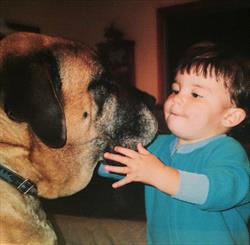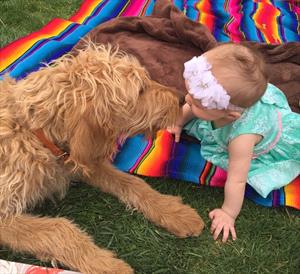Many parents mistakenly think a child-friendly dog means the dog should tolerate anything a child does. Although kids and dogs can, and often do, have great relationships, it may not be as easy as it seems. Children are unpredictable because they make loud noises and move suddenly, causing even the most mild-mannered dog to become frightened and overwhelmed. Any dog, even one who loves kids, can bite if they feel threatened, especially if they can’t escape the situation. Research shows that kids are most often bitten by a dog they know. In these situations, adults may not be watching or believe their dog would bite.
Inappropriate Interactions
Child Holding Dog's Face

The above interaction is not recommended (as outlined in the article). Photo courtesy Heather Howell, LVT, RVT, MBA
Parents should actively monitor interactions between children and dogs for potentially dangerous situations. When interacting with your dog, do not allow children to:
- put their face in the dog’s face, hug, or kiss
- play roughly or wrestle
- tease
- take away, play or put their hands in the dog’s food dish
- run near or approach a dog who is seated or lying down because this may seem threatening to the dog
Prevention
Adults should actively engage with the children and dogs. When direct supervision is not possible, separate the dogs and children using barriers. Provide your dog with their own space. This should be a closed room or secure crate with everything your dog needs. Baby gates can be used to set up this safe haven. Teach your dog to love their special place and teach the children to never approach when the dog is resting there.
Learn Your Dog’s Language
Children are more at risk of dog bites because they haven’t been taught how to read a dog’s body language and can’t assess the danger. Dogs will often display subtle signs of discomfort, such as yawning and avoiding eye contact, before escalating to more obvious signs such as growling. By watching for these signs, you can step in to safely manage the situation by guiding your dog away from the child. If ignored or punished, then your dog is more likely to bite “out of the blue”.
Teach your children to recognize your dog’s body language by using children’s books, videos, and coloring pages. Adults still need to manage all child/dog interactions.
Structured Interactions
Show children appropriate ways to interact with dogs so they can be safe. Structured, predictable interactions between dogs and children can build positive relationships. With adult supervision, the following activities are appropriate for children with dogs who have never shown aggression:
Fetch -
Using two or more toys, older children can play fetch without needing to take toys away from the dog. The child tosses the first toy and when the dog returns, they toss the next toy.
Flirt pole -
For dogs who love to chase, attach a plush toy to a rope and stick that your child can hold. Using the flirt pole the same way you would a cat wand, let the dog chase the toy. Always finish the game with a treat.
Training -
Involving kids with the dog’s training can help create a strong, positive bond between them. Start training sessions with cues the dog already knows, like “sit”.
Tossing treats or kibble -
Another simple but effective game is to have kids toss either treats or kibble across the room for the dog.
Teach your child to freeze in place if your dog starts chasing or jumping at them. More movement or noise from children will encourage the dog to continue. If you have taught recall or “touch”, call your dog to you. If your dog does not come when called, they should be leashed.
Visitors
Child face to face with dog

The above interaction is not recommended (as outlined in the article). Photo courtesy of Heather Howell, LVT, RVT, MBA.
Visitors can mean more excitement and activity in the house. Visiting children may have little experience or be overly comfortable with dogs, leading to inappropriate interactions. Even kid-savvy dogs may be uncomfortable sharing their home and space, leading to a growl or bite. When visitors with children come over, use the dog’s safe haven, and keep them away from the excitement.
Avoid Punishment
When creating happy, peaceful relationships between children and dogs, punishment is never appropriate. In scary situations, punishing a frightened dog can ruin relationships and doesn’t change the underlying issue.
Safety is the priority when managing relationships between dogs and children. If you are having a hard time creating positive interactions or your dog has shown aggression, contact a behavior professional for assistance.